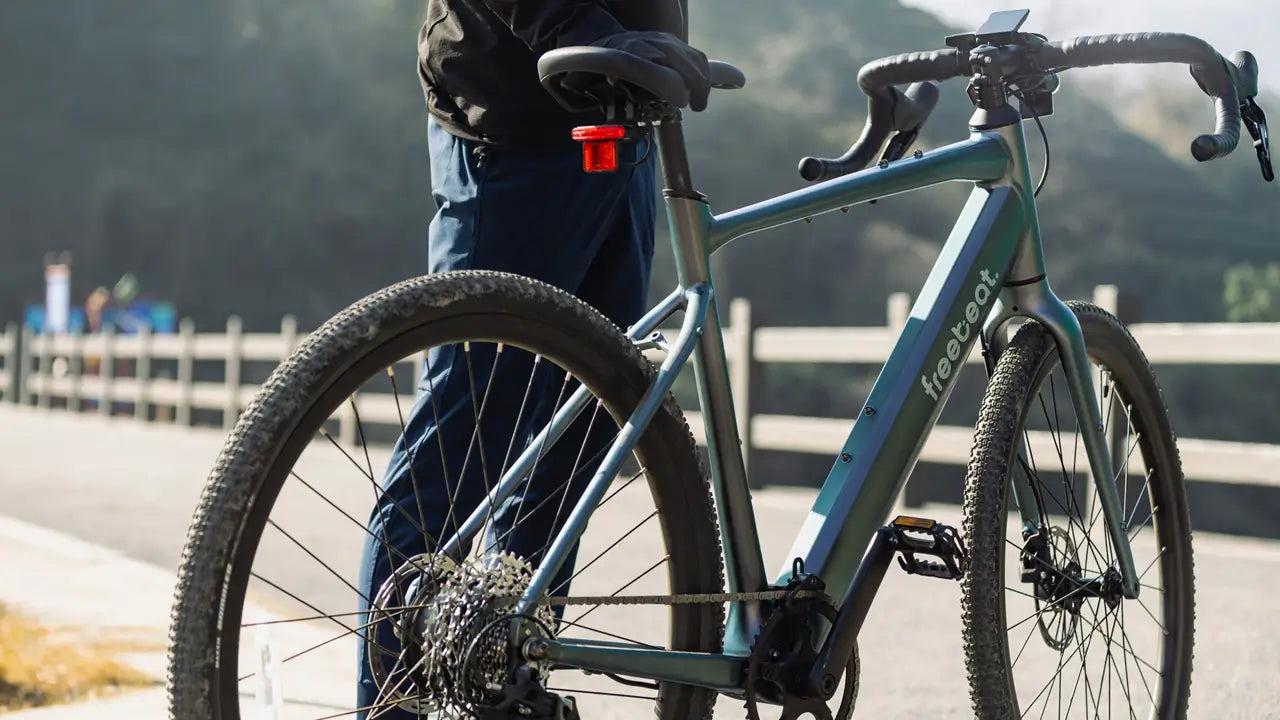Gravel Bike vs Road Bike: A Complete Comparison for Cyclists
Whether you're cruising on a scenic byway or cutting through the woods on a muddy trail, the right bike can make all the difference in your cycling experience. For cycling enthusiasts and professionals alike, the debate between a gravel bike and a road bike is not just about two-wheel travel; it's about the nuances that define your ride – from the kind of terrain you tackle, to the very style of cycling you enjoy.
In this comprehensive comparison, we'll explore the distinct features, purposes, and performances of these two bike types within the cycling world, guiding you to the perfect choice for your next adventure on the pedals.
Gravel Bike vs. Road Bike: What's the Difference?
At first glance, the distinction between a gravel bike and a road bike may seem subtle. Both have similar silhouettes, shiny gears, and the inescapable allure that only two wheels and a pair of pedals can convey. Nevertheless, their design and purpose pave the way for a wide gap in performance and utility.
Unveiling the Gravel Bike

Here's a closer look at what makes the gravel bike unique:
Key Features of the Gravel Bike
-
Tire Clearance: Gravel bikes typically feature wider tire clearance than road bikes, accommodating tires ranging from 32mm to beyond 50mm. This allows them to handle a variety of rough road conditions with greater stability and comfort.
-
Geometry: The geometry of a gravel bike is more relaxed than that of a road bike. This means a more upright riding position, which is less aggressive and strain-free, especially on long rides.
-
Frame Build: Gravel bike frames are often made from robust materials such as aluminum, steel, or carbon, to withstand the vibrations and shocks of rough terrain.
-
Brakes: Most gravel bikes now come equipped with disc brakes, providing better stopping power and performance, especially in wet or muddy conditions.
-
Additional Features: Gravel bikes often have provisions for extra bottle cages, luggage racks, and fenders, catering to the needs of bikepackers and adventure cyclists.
Demystifying the Road Bike

Key Features of the Road Bike
-
Tire Profile: Road bike tires are narrow and have a smooth, flat profile to reduce rolling resistance on paved surfaces. They're typically around 23mm to 28mm wide.
-
Geometry: Road bikes are characterized by their aggressive geometry, which promotes an aerodynamic riding position. This position aims to maximize the power output of the rider for speed.
-
Frame Build: Frames of a road bike are often made from lightweight materials like carbon fiber or high-grade aluminum to ensure they're as light as possible.
-
Brakes: Traditional road bikes come with rim brakes, although many modern road bikes are now equipped with disc brakes for improved stopping power and safety.
-
Additional Features: Road bikes are streamlined for speed and do not typically have mounts for racks or fenders.
The Middle Road: All-Road and Endurance Bikes
Not all bikes sit at the polar extremes of road and gravel specifics. All-road bikes and endurance road bikes offer an intermediate experience that appeals to a wide range of cyclists, blending features from both categories.
All-Road Bikes
All-road bikes are essentially a scaled-down version of a gravel bike, with a geometry that's slightly more aggressive, more in line with a classic road bike, yet with increased tire clearance to handle a variety of surfaces.
Endurance Road Bikes
Endurance road bikes, on the other hand, take the comfort of a gravel bike's geometry and apply it to road-focused frames with only moderate increases in tire clearance. They are designed for the long haul, focusing on comfort and ride quality over out-and-out speed.
The Great Divide: Which One is Right for You?
Choosing between a gravel bike or a road bike ultimately boils down to personal preference and intended use. Both are fantastic options, each with its strengths and weaknesses. To help you decide which one fits you best, here are some key points to consider:
#1 Suitability for Terrain
The terrain you intend to ride on is a significant factor in choosing between a gravel bike and a road bike. Here's how each bike fares in different environments:
If your heart is set on the open road, the road bike is the way to go. Its lightweight build and narrow tires minimize resistance, making it the fastest choice on pavements and other hard, even surfaces.

When your day's itinerary includes more dirt, gravel, and unpredictable surfaces, the gravel bike shines. Its wider, grippier tires provide traction and stability, while the geometry of the frame keeps the rider in a more upright position, enhancing comfort and control over rough terrain.

#2 Riding Experience
The bikes' suitability for the terrain shapes the overall riding experience. While both bikes provide unique joys, these differences significantly impact the way you ride:
Road Biking
Cruising on a road bike offers a 'zen' experience of sorts. The smooth, rhythmic pedal strokes taking you further with each thrust, the sensation of speed captured in each airstream whisper—the road bike is all about efficiency. It's a great tool for clearing the mind, pushing for personal bests, or simply enjoying the countryside. Endurance road bikes extend this bliss to longer distances, with additional features for comfort and carrying essentials.
Exploring the Gravel
Opting for a gravel bike entails a more exploratory type of adventure. It's the bike for those who love to turn off the beaten path, chase sunsets on distant horizons, and feel the gentle hum of tires rolling over graveled backroads. The riding position offers a wide view, enabling you to take in the picturesque landscapes while tackling a variety of terrains. Gravel bikes open up a realm of possibilities, from mild off-roading to full-fledged bikepacking expeditions.
#3 Technical Specifications
A deeper look into the technical features will help you understand why each bike is what it is. Here are the main components that differentiate them:
Frame and Geometry
Road bike frames are typically more aggressive, placing the rider in a more aerodynamic position to maximize speed. Gravel bikes have a more relaxed geometry, providing a more upright riding position for comfort and to handle varied terrain.
Tires and Wheels
The tires on road bikes are thinner, smoother, and more lightweight, emphasizing speed. Gravel bike tires are typically wider, with a more pronounced tread pattern, offering better grip and puncture resistance on rougher surfaces.
Gearing
Road bikes tend to have a wide range of gears suitable for high speeds on flat surfaces and climbing steep hills. Gravel bikes often have lower gearing to handle off-road terrain and steep grades more comfortably.
#4 Considerations for New Cyclists
If you're new to cycling, the choice between a gravel bike and a road bike may seem daunting. Here are a few factors to consider to ensure you make the right choice:
Your Riding Goals
What do you want to achieve with your cycling? If you're inspired to complete a long-distance charity ride or have your sights set on a triathlon, a road bike could be your best ally. For those who look forward to the prospect of exploring bike trails and tracks, a gravel bike may open up more possibilities.
Comfort and Fit
Getting the right size and fit for your bike is crucial for comfort and preventing injury. Endurance road bikes offer a more relaxed geometry, which can be friendlier for beginners. Gravel bikes often come with features that enhance comfort, such as a taller head tube and more compliance in the frame and forks.

Versatility
Consider how you plan to use your bike. Gravel bikes, with their versatility and ability to handle various terrains, might be a better option if you're unsure of the type of biking you'll be doing or want a bike that you can adapt to for different purposes. Gravel bikes have opened up new possibilities for riders, allowing them to venture off the beaten path and explore the countryside in ways that were previously not possible on a road bike.
When to Choose a Road Bike
Opt for a road bike if your primary cycling interest lies in fast-paced road riding, competitive racing on smooth surfaces, or if you’re seeking a bike for fitness riding and participating in group rides.
When to Choose a Gravel Bike
Gravel bikes are the ideal choice for those who want to explore a variety of terrains without needing multiple bikes. They shine in long-distance events like gravel grinders and provide a smooth ride over mixed surfaces.
Are Gravel Bikes Good On The Road?
The answer is both yes and no. While gravel bikes can handle road riding and provide a comfortable and enjoyable experience, they may not be as fast as a dedicated road bike. This is due to their wider tires and more relaxed geometry, which can add some extra weight and resistance on paved roads.
However, for the average cyclist who enjoys a mix of road and off-road riding, a gravel bike offers the best of both worlds. It allows for exploration and adventure without sacrificing too much on speed and performance. Ultimately, the choice between a gravel bike or road bike depends on your personal riding preferences and needs. So, choose wisely based on your riding style and terrain preferences to get the most out of your cycling experience.
Can A Road Bike Go Off The Road?
The Verdict
There isn't a one-size-fits-all answer when it comes to choosing between a gravel bike and a road bike—it all boils down to your personal preferences, riding style, and the type of terrain you intend to conquer. Both bikes offer unique advantages and respective use cases. and is the one that aligns with your cycling goals and lifestyle.
Whether you're a speed demon on paved roads or an adventure seeker off the beaten path, there's the best bike for you. The gravel vs road bike debate may continue, but ultimately, it's all about finding the right fit for your personal cycling journey. Keep exploring, keep pushing your limits, and most importantly, keep having fun on two wheels. See you out on the road (or gravel)!






















 0% APR financing for 24-month payments.
0% APR financing for 24-month payments.